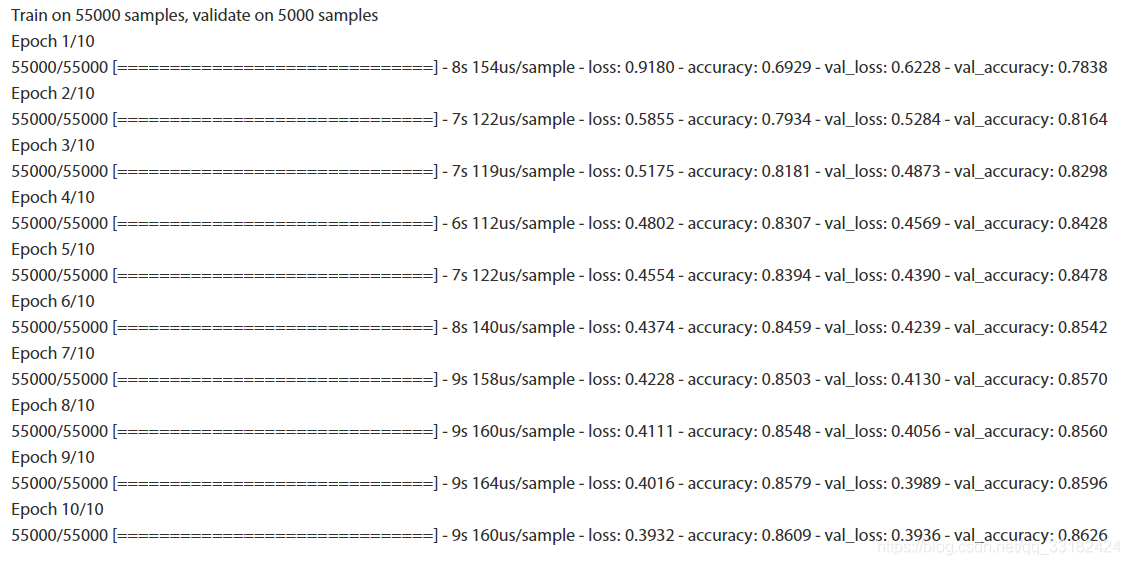
Tensorflow2.0初探——keras回调函数、实现简单的图像分类、归一化
发布于2020-03-27 09:35 阅读(2186) 评论(0) 点赞(10) 收藏(1)
1、引入相应的库
import matplotlib as mpl
import matplotlib.pyplot as plt
%matplotlib inline
import numpy as np
import sklearn
import pandas as pd
import os
import sys
import time
import tensorflow as tf
from tensorflow import keras
print(tf.__version__)
print(sys.version_info)
for module in mpl, np, pd, sklearn, tf, keras:
print(module.__name__, module.__version__)

2、导入数据
fashion_mnist = keras.datasets.fashion_mnist
(x_train_all, y_train_all), (x_test, y_test) = fashion_mnist.load_data()
x_valid, x_train = x_train_all[:5000], x_train_all[5000:]
y_valid, y_train = y_train_all[:5000], y_train_all[5000:]
print(x_valid.shape, y_valid.shape)
print(x_train.shape, y_train.shape)
print(x_test.shape, y_test.shape)

3、数据归一化
#均值为0,方差为1
# x = (x - u) / std
from sklearn.preprocessing import StandardScaler
scaler = StandardScaler()
# x_train: [None, 28, 28] -> [None, 784]
x_train_scaled = scaler.fit_transform(
x_train.astype(np.float32).reshape(-1, 1)).reshape(-1, 28, 28)
x_valid_scaled = scaler.transform(
x_valid.astype(np.float32).reshape(-1, 1)).reshape(-1, 28, 28)
x_test_scaled = scaler.transform(
x_test.astype(np.float32).reshape(-1, 1)).reshape(-1, 28, 28)
4、创建模型
# tf.keras.models.Sequential()
"""
model = keras.models.Sequential()
model.add(keras.layers.Flatten(input_shape=[28, 28]))
model.add(keras.layers.Dense(300, activation="relu"))
model.add(keras.layers.Dense(100, activation="relu"))
model.add(keras.layers.Dense(10, activation="softmax"))
"""
model = keras.models.Sequential([
keras.layers.Flatten(input_shape=[28, 28]),
keras.layers.Dense(300, activation='relu'),
keras.layers.Dense(100, activation='relu'),
keras.layers.Dense(10, activation='softmax')
])
# relu: y = max(0, x)
# softmax: 将向量变成概率分布. x = [x1, x2, x3],
# y = [e^x1/sum, e^x2/sum, e^x3/sum], sum = e^x1 + e^x2 + e^x3
# reason for sparse: y->index. y->one_hot->[]
model.compile(loss="sparse_categorical_crossentropy",
optimizer = "sgd",
metrics = ["accuracy"])
5、定义回调函数callback
# Tensorboard, earlystopping, ModelCheckpoint
logdir = './callbacks'
if not os.path.exists(logdir):
os.mkdir(logdir)
output_model_file = os.path.join(logdir,
"fashion_mnist_model.h5")
callbacks = [
keras.callbacks.TensorBoard(logdir),
keras.callbacks.ModelCheckpoint(output_model_file,
save_best_only = True),
keras.callbacks.EarlyStopping(patience=5, min_delta=1e-3),
]
history = model.fit(x_train_scaled, y_train, epochs=10,
validation_data=(x_valid_scaled, y_valid),
callbacks = callbacks)

6、绘制各项训练数据图像
def plot_learning_curves(history):
pd.DataFrame(history.history).plot(figsize=(8, 5))
plt.grid(True)
plt.gca().set_ylim(0, 1)
plt.show()
plot_learning_curves(history)

7、评估验证函数
model.evaluate(x_test_scaled, y_test)

所属网站分类: 技术文章 > 博客
作者:imsorry
链接:https://www.pythonheidong.com/blog/article/286715/4de120fa81e877264b67/
来源:python黑洞网
任何形式的转载都请注明出处,如有侵权 一经发现 必将追究其法律责任
昵称:
评论内容:(最多支持255个字符)
---无人问津也好,技不如人也罢,你都要试着安静下来,去做自己该做的事,而不是让内心的烦躁、焦虑,坏掉你本来就不多的热情和定力